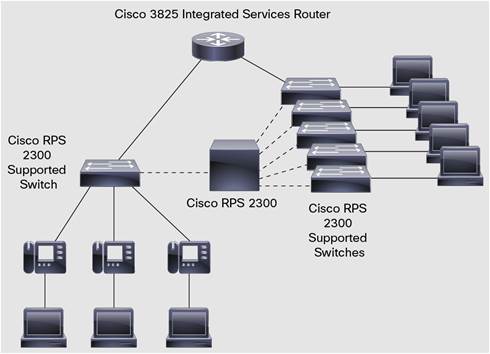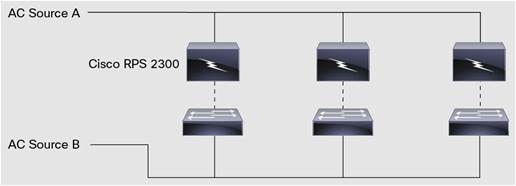
Do you need the Cisco RPS 2300 for your Cisco 2960-X, or 2960-S switches? How much do you know about the Cisco RPS 2300? What’s the main feature of Cisco RPS 2300? If you have these questions, you should read this article that contains the main points of Cisco RPS 2300.
Cisco RPS 2300, the full name is CiscoRedundant Power System 2300, delivers power supply redundancy and resiliency for a variety of power requirements, including Power over Ethernet (PoE). The more important is that RPS 2300 helps ensure uninterrupted operation and protection against device power supply failures by providing seamless failover for Cisco switches such as the Cisco Catalyst 2960-X, 2960-S, 2960-Plus, 2960, 3750-E Series Switches and Cisco routers such as the Cisco 3825 Integrated Services Routers. It increases availability for converged data, voice, and video networks.
The Cisco RPS 2300 supplies redundant power for up to two of six connected 48-port PoE devices in a convenient, 1-rack-unit form factor. When attached to Cisco Catalyst 2960-X, 2960-S, 3750-E, 3560-E Series and Meraki Switches, the Cisco RPS 2300 offers additional intelligent management capabilities.
Cisco RPS 2300
Flexibility and High Availability: The Cisco RPS 2300 can provide complete internal power supply redundancy for up to two attached networking devices. It has two power supply bays and can accept 1150W AC or 750W AC power supply modules. These power supply modules are also used with Cisco Catalyst 2960-X, 2960-Plus, 2960-S, 2960, 3750-E, 3560-E Series and Meraki Switches. With two 1150W AC power supply modules, the Cisco RPS 2300 can fully back up two 48-port switches that are delivering 15.4W of PoE on all ports. The Cisco RPS 2300 also has a replaceable fan module.
Ease of Use: When connected to Cisco Catalyst 2960-X, 2960-S, 3750-E, 3560-E Series and Meraki Switches, the Cisco RPS 2300 offers enhanced capabilities to manage power supply redundancy, including:
- The ability to remotely place the RPS or any of the six individual RPS ports in active or standby mode
- Setting priorities for each RPS port
- RPS status reporting, such as the number of power supplies inserted or the availability to back up connected switches
- Switch status reporting, such as a list of the power requirements of each of the attached switches
- Failure and exception history reporting
These capabilities are accessible through the switch’s command line interface (CLI), or through graphical user interface (GUI) tools such as the Cisco Network Assistant and CiscoWorks CiscoView.
The default failover behavior for the RPS is “first-come, first-served.” Default priorities can be overridden with a programmable priority, and higher-priority ports can be programmed to supersede lower-priority ports. This feature gives the network administrator the flexibility to define the RPS failover policy.
When a failure is detected, the Cisco RPS 2300 sends status information that can be monitored through Cisco Network Assistant. In addition, Cisco Catalyst 3750-E, 3750, 3560-E, 3560, 3550, 2960, and 2950 Series Switches send a trap in the event of an internal power supply failure, allowing the Cisco RPS 2300 to back up the failed switch.
Cisco RPS 2300 is Applied to a Variety of Situations
The Cisco RPS 2300 can be deployed in a variety of situations to help ensure network resiliency for mission-critical applications. Figure 2 shows the Cisco RPS 2300 in a converged voice and data network that includes switches connected to IP phones and PCs. In the event of a switch’s internal power supply failure, the Cisco RPS 2300 helps ensure voice and data network operation without interruption. In this scenario, multiple PoE switches are attached to the Cisco RPS 2300.
10/100 IP Phone and Desktop Computer Connections
When designing or upgrading a wiring closet, careful consideration should be given to power requirements, particularly for PoE deployments. A power architecture can be selected based on the level of availability desired. The primary power faults to protect against include:
- Internal power supply failures in network devices
- Failure of an AC circuit (a circuit breaker tripping, for example)
- Interruption of utility power
The Cisco RPS 2300 can address the first two issues. The last issue requires an uninterruptible power supply (UPS). With a single AC circuit, regardless of whether it is from a UPS, the RPS provides protection against a power supply failure for up to two attached devices. With a second circuit (Figure 4), again regardless of whether it is from a UPS, the RPS provides protection not only from an internal power supply failure but also a failure of the primary AC source. For maximum availability, the RPS should always be used in conjunction with a UPS (Figure 5).
Cisco RPS 2300 Using the Same AC Circuit as the Connected Network Devices
Cisco RPS 2300 Using a Different Circuit from the Connected Network Devices
Using the Cisco RPS 2300 and Connected Network Devices with a UPS for Maximum Availability
Cisco RPS 2300-Features and Benefits
High Availability/Increased Network Uptime
- Modular power supplies and a fan module offer enhanced availability.
- Less than 60-µs failover capability prevents switch reboot after an internal switch power failure.
- When backed up by a Cisco RPS 2300, a Cisco Catalyst 2960-X, 2960-S, 3750-E, or 3560-E Series Switch is capable of reverting back to its own power supply without rebooting. All other devices may reboot when reverting back to their own power supplies.
- The system supports traditional data-only Ethernet switches as well as PoE switches.
- The system is capable of providing AC source backup when separate circuits are used for the RPS and attached devices.
Ease of Use and Ease of Deployment
- Modular power supplies offer configuration flexibility.
- The system, or individual RPS ports, can be remotely placed in active or standby mode.
- 1-rack-unit form factor provides for efficient wiring closet space utilization
- The system offers configurable RPS port priorities and failover policy.
- Enhanced management capabilities are available through Cisco Catalyst 2960-X, 2960-S, 3750-E, and 3560-E Series Switches. Users can identify and monitor the following activity on the Cisco RPS 2300, using CLI, the CiscoWorks LMS or Cisco Network Assistant network management applications:
- Switch connectivity and power requirements
- Power delivery status for individual RPS ports
- Net power usage
- Backup, failure, and exception history
- The system enables hot insertion of external devices and modular power supplies
- LEDs on front panel and power supplies indicate system and power status.
Cost-Effective Solution
- Innovative power architecture delivers a cost-effective RPS that can connect up to six devices and can actively back-up up to two devices simultaneously, thereby reducing the redundant power cost per device.
- The system supports a wide variety of Cisco Catalyst fixed configuration switches and Cisco Integrated Services Routers.
Supported Products
- Cisco Catalyst 2960-X Series Switches
- Cisco Catalyst 2960-Plus Series Switches
- Cisco Catalyst 2960-S Series Switches
- Cisco Catalyst 3750-E Series Switches
- Cisco Catalyst 3560-E Series Switches
- Cisco Catalyst 3750v2 Series Switches
- Cisco Catalyst 3750 Series Switches
- Cisco Catalyst 3560v2 Series Switches
- Cisco Catalyst 3560 Series Switches
- Cisco Catalyst 3550 Series Switches
- Cisco Catalyst 2960 Series Switches
- Cisco Catalyst 2950 Series Switches
- Cisco Catalyst Express 500 Series Switches (Select PoE models only)
- Cisco Meraki MS220 (24/48 port) Switches
- Cisco 3825 Integrated Services Routers
- Cisco 2851 Integrated Services Routers
- Cisco 2821 Integrated Services Routers
- Cisco 2811 Integrated Services Routers
Modular Power Supplies
Cisco RPS 2300 users can choose between two power supplies that are also compatible with Cisco Catalyst 3750-E and 3560-E Series Switches:
- The C3K-PWR-1150WAC power supply
- The C3K-PWR-750WAC power supply
The Cisco RPS 2300 can operate with one or two power supplies. If two power supplies are installed, they must be of the same type. Table 1 shows the number of switches that can be simultaneously backed up by the Cisco RPS 2300 for its different configurations.
Number of Switches Actively Backed Up by Cisco RPS 2300
| Cisco RPS 2300 Configuration | ||||
| 1 x 750W | 2 x 750W | 1 x 1150W | 2 x 1150W | |
| Cisco Catalyst 3750E or 3560E switches with 1150W power supply | Not supported | 1 | 1 | 2 |
| All other supported network devices | 1 | 2 | 1 | 2 |
Power Supply Compatibility Matrix
| Cisco Supported Catalyst Switch and RPS Type | Power Supply | |
| C3K-PWR-1150WAC | C3K-PWR-750WAC | |
| 48-Port PoE Switch | √ | √ |
| 24-Port PoE Switch | √ | √ |
| 48-Port Switch | √ | √ |
| 24-Port Switch | √ | √ |
| Cisco RPS 2300 | √ | √ |
Any other details? If you wanna read more about RPS 2300 such as the Connectors and Cabling, Fans, Accessory Kit, MTBF for the RPS 2300, Power Supply Specifications, etc. . You can read the full page
More Related Cisco Power Supply Topics
Cisco Catalyst 4500E 9000W Power Supply Review










